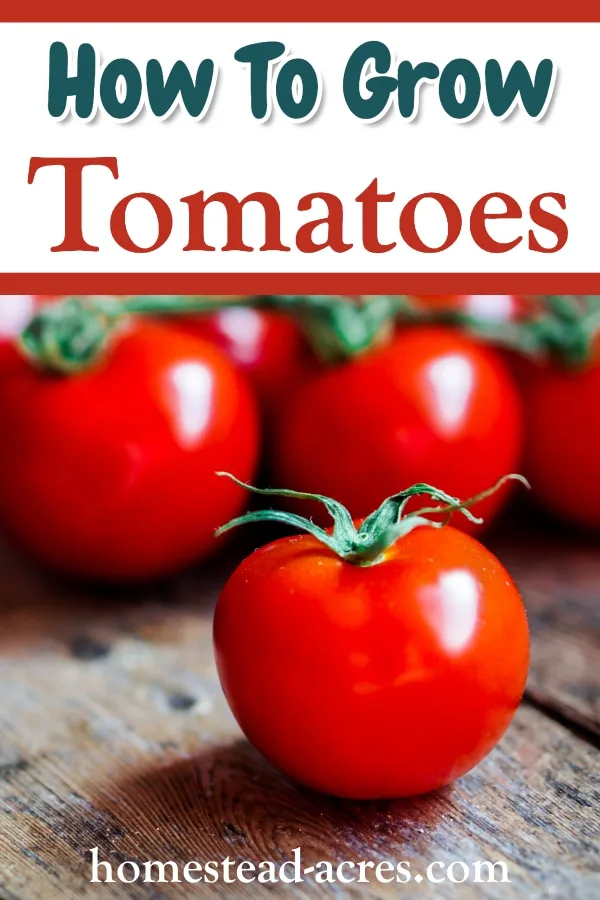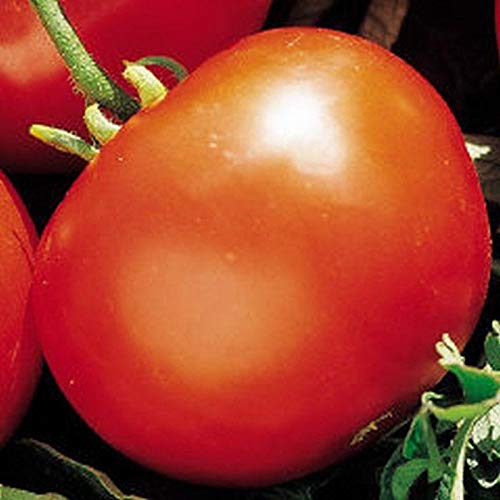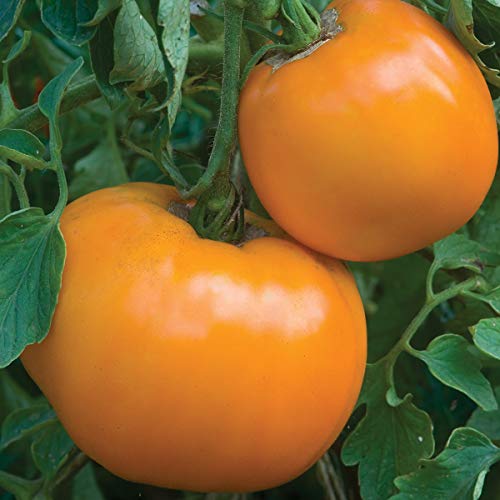This post may contain affiliate links, my full disclosure can be read here. As an Amazon Associate I earn from qualifying purchases.
How to grow tomatoes in your garden even if you are a beginner! Enjoy lots of fresh homegrown tomatoes all season long.
Tomato plants can really be considered the king of the garden.
As the summer season starts to mature tomato plants are reaching their full size in August and the long vines are loaded with fruit in many shades of green, orange, yellow, purple, black, pink and yes of course red.
Once you start gardening tomatoes just seem to have a way of taking over your garden. You can’t grow just one plant or one type.

No, as time goes on you start adding more varieties of tomatoes to your garden and enjoying all the wonderful types from cherry tomatoes, huge heirloom beefsteaks, large ox hearts and of course paste tomatoes.
How To Grow Tomatoes

Determinate or Indeterminate
One of the first things you need to think about when growing tomatoes is what type of tomatoes you want to grow. Now I don’t mean varieties but type.
See tomatoes come in 2 very different groups.
Determinate tomatoes grow to a predetermined size, normally 4 to 5 feet. They also produce all of their fruit during a very short time period. These are often called bush tomatoes.
If you want all of your tomatoes to be harvest within a few weeks of each other this is a great choice for you, and many people who love to can tomatoes like to grow bush varieties.
Indeterminate tomatoes are different in that they will keep growing all season long.
These plants grow as a long vine and can easily reach 7-10 feet when grown outside and longer when grown in a greenhouse. These are often called vining or staking tomatoes.
Indeterminate plants will keep flowering and producing their fruit right up until the frost kills the plants in the fall. These are perfect to grow if you want to have a continuous harvest of tomatoes all summer.
Learn more about determinate and indeterminate tomatoes and how to pick the best one for your garden.
When To Plant Tomatoes
After a long winter, it’s so tempting to plant the tomato plants into your garden as early as possible but unless you are protecting them properly that will turn out to be a big mistake.
Tomatoes are a warm-season plant that really doesn’t tolerate cold weather well.
It’s best to wait until 2 weeks after your last frost date has past to plant tomatoes because this gives your soil a chance to warm up enough to get the tomato plants off to a good start.
Normally by this time the weather has also stabilized and is warm enough for tomatoes to love growing outside.
Remember to take care to harden off your young plants before transplanting them into the garden though. Whether you’ve started tomatoes from seed or bought plants from your local nursery they have been growing in sheltered conditions all of their life.
If you take a tomato plant that’s been growing indoors and plant it right into your garden it will likely die.
Don’t worry, hardening off your tomatoes isn’t hard to do at all. It’s simply taking a little time to get your tomatoes used to growing in the outdoor conditions.
To start getting the tomato plants used to the wind and direct sunlight place the plants outside for a little while in the morning about 20 to 30 minutes is good, then bring them back inside.
Do this over the course of a week, leaving the plants outside a little longer each time. Once they can spend a full day outside without wilting or looking stressed they are ready to plant into your garden.
How To Plant Tomatoes

Before planting tomatoes make sure to add lots of good compost or well-rotted manure to your garden bed.
Tomato plants will grow roots all along its stem where it touches the ground. So it’s best to plant tomatoes as deep as possible.
Try to bury at least half the stem in the soil but I’ve found even better results planting them deep enough to cover the stem to 1 inch below the first set of leaves.
The plant will produce roots all along the stem underground, which will make it more tolerant of droughts and help to protect it from blossom end rot a common tomato problem.
After digging the right sized hole, fill it up with liquid fertilizer. My favorite to use is fish emulsion or liquid seaweed. As soon as the planting hole is full, place the tomato plant inside and pull the soil back around the plant.
Then gently firm down the soil around the plant so the roots have good contact with the soil.
Taking the time to add the extra fertilizer and water to the hole when planting tomatoes really helps the plant to get off to a great start and avoid transplanting shock.
We’ve found since we first started doing this the plants start growing right away with no signs of wilting after planting.
After planting water your plants well and place at least 2 inches of mulch around the plants to help retain the moisture and reduce weeds.
With the right care you can really increase your tomato yields.
Cold Protection For Tomato Plants
Tomato plants really need warm temperatures and soil to grow well.
If you live in a cooler growing zone or have been hit with an unusually cold summer, help your plants out by laying black plastic over the soil before planting.
It will really help to raise the soil temperatures and you can also leave it on if you want through the growing season as a weed barrier too, although I prefer to use natural mulches like wood chips or straw.
Another way to protect young tomato plants from cold weather and strong winds to make a mini-greenhouse around each plant.
This is a common method used by many farmers in our area for their home gardens. It’s easy, cheap and really works well for protecting tomatoes.
But if you want to plant tomatoes out into your garden before your last frost date there is a better way to protect them.
If you want to plant your tomatoes outside 3 to 4 weeks before your last frost date then you need to use a mini hoop house.
First, lay black plastic over the garden bed where you want to plant your tomatoes for a few weeks before planting to warm the soil. Then remove it and transplant the tomato seedlings into your garden.
After that place wire hoops (you can also use PVC) over the tomato bed and cover it with either a floating row cover or plastic.
Floating row covers come in different thicknesses depending on how much frost protection you need.
They have the advantage of allowing water and air to still flow through the cloth while also keeping the plants warm. Think of it like an insulating blanket that still breathes.
Plastic, on the other hand, won’t let the water through and blocks out all of the airflow. It will let more light in compared to a floating row cover and can get very hot when the sun is shining.
If you are using plastic remember to open the ends of the tunnel to vent the hot air out on mild days.
How Long Does It Take To Grow Tomatoes

There are so many varieties of tomatoes you can grow, but on average most tomato plants will start producing fruit in 60 to 80 days.
Remember when deciding what variety of tomatoes to grow that the days to maturity listed on the seed packet is not from the date that you started the tomato seeds, but from the date, you transplant the tomatoes into your garden.
If you transplanted a 60-day tomato plant into your garden on June 1st you should start expecting ripe tomatoes around August 1st.
Of course, this will also depend on the weather conditions of your growing season.
How To Water Tomatoes
Tomatoes really need an even supply of water to grow well. Plants growing in long periods of drought conditions then followed by heavy rains can cause many problems including blossom end rot and splitting.
This is another good reason for watering your tomato plants less often but more deeply.
In normal growing conditions, tomatoes need 1 to 2 inches of water each week.
How To Fertilize Tomatoes
For the best growth fertilize tomato plants at the time of planting. The easiest way to do this is to add fertilizer to the bottom of the planting hole.
If you are using compost simply place a good handful in the bottom and you’re done.
Anything else should be mixed into the soil at the bottom of the hole and have a layer of soil or compost placed above it to keep the tomato roots from touching the fertilizer directly and prevent burning.
After this, if your garden soil is already very fertile the tomatoes will only need to be fertilized once a month.
However, if you have poor quality soil or really want to boost the growth of the tomatoes you can fertilize every 2 weeks with compost tea or fish emulsion.
How Much Sunlight Do Tomato Plants Need?
Tomato plants will grow and produce fruit as long as they get 6 hours of sunlight each day, but 8 to 10 hours of light is even better for higher fruit yields.
As much as the sunlight hours is important when growing tomato plants remember that soil quality can be even more important.
We have had tomato plants growing in areas of our garden that got about 6 hours of daylight each day and they outperformed other plants grown in full sun simply because the soil they were grown in was very rich compost.
If possible try to plant your tomatoes so they have full sun in the morning when the light is very intense but it’s not that hot outside yet.
Tomatoes will appreciate some shade during midday when the sun is the strongest and the heat is at its peak too, while later afternoon light is helpful as the day starts to cool down.
How Tall Do Tomatoes Grow?
How high your tomato plants will grow really depends on what type and the variety you’re growing. On average, a determinate (bush) tomato plant will grow 3 to 5 feet tall while an indeterminate (vining) tomato plant will grow 7 to 8 feet or taller.
Support
It’s really important to provide tomato plants with good support. If you don’t they will spiral along the ground. This increases their risk for blight, and bug damage. Not to mention it’s a lot harder to pick tomatoes like that.
To get the best results you need to stake or cage your tomato plants.
For determinate tomatoes, a strong tomato cage will work well, or using the Florida weave method to tye them up has worked very well for use in our gardens.
If you are growing indeterminate tomatoes then you will need a strong trellis or tall stakes. Remember that these types of tomatoes grow very tall so try to make it at least 6 feet high.
Cattle panels make great trellises for tomatoes and other vining vegetables and will last you for years. But you can get the job done with a strong string or nylon netting too.
Harvesting Tomatoes

Harvesting has to be the best part of growing tomatoes! After all, this is why you’re growing them in the first place right?
Whether you want to make tomato sauce, salsa, or just enjoy a great salad knowing when your tomatoes are ripe will give you the best taste.
Knowing when red varieties of tomatoes are ripe is really easy. Just wait until the tomato has fully turned red, and there are not green or pink areas left. The tomato should be firm with just a little give on the bottom.
Knowing how to feel the tomato for ripeness is especially important when growing tomatoes that turn different colors like purple, green or are striped because the colors can be deceiving.
After all, if you are growing a green tomato variety they start green and end green, you need to go by how firm or soft the tomato is instead.
Some tomatoes are very prone to skin cracking, especially cherry tomatoes so these should be harvested as soon as they are ripe or even just slightly underripe if you are expecting rain.
Make sure to save some of the best tomatoes to keep seeds from for next years garden too.
Later in the growing season if you are expecting a hard frost pick all of the remaining tomatoes and wrap them individually in newspaper or place them in layers with paper in-between and place them in a cool dry area to slowly ripen.
Varieties Of Tomatoes
There are so many varieties of tomatoes you can grow in your garden, it can seem overwhelming to know what you should try.
These are some tomato varieties we have grown over the years that have done very well for us in our zone 5 gardens.
Bush Beef
If you are looking for an early beefsteak tomato Bush Beef is a great one to try!
These heirloom tomatoes are a determinate variety that grows into compact bushy plants and produces early in the season.
They produce lots of deep red, large 8 oz (250 g) tomatoes that are perfect for slicing and enjoying on hamburgers and sandwiches.
It’s a determinate (bush) type and matures in 62 days.
Manitoba
Manitoba Tomato – An extremely early heirloom tomato!
Manitoba tomatoes are an open-pollinated tomato developed in the mid-1950s to ripen during the short summer growing seasons of the prairies. I’ve found them to be a reliable tomato in our zone 5 gardens too.
They produce medium-large, meaty tomatoes 6 oz (170 g) that are bright red in color. This variety is great for slicing and preserving.
It’s a determinate (bush) type and matures in 65 days.
Golden Queen
Burpee ‘Jubilee’ | Large Yellow Beefsteak Tomato
Golden Queen often called Jubilee tomatoes are a yellow heirloom tomato developed in the early 1880s.
It produces large 8-12 oz (200-300 g), thick-walled and meaty tomatoes that are low acid and have a wonderful, mild taste.
It’s an indeterminate (vine) type and matures in 75 days.
Elizabeth
Elizabeth is one of my all-time favorite tomatoes to grow but it can be harder to find in seed catalogs. Sometimes it’s called Elizabeth, Elizabeth Roma, or Elizabeth Stefancsik.
This heirloom tomato was developed by Mike Stefancsik and named after his wife Elizabeth, although some sources say it was his mother.
It produces 2 oz fruit that is oval-shaped like a paste tomato. Some are solid red and others are red with speckled gold stripes. These have an amazing tomato flavor and are slightly sweet.
Elizabeth is a vigorous indeterminate tomato that grows to over 10 feet tall and produces huge amounts of fruit per plant.
We’ve grown this variety in our greenhouses and in the field and as long as they are supported they have produces extremely well.
While they are often called a Roma tomato because of their shape, many class them as a small slicer because they are juicier than most Roma types. We grow this as our main canning and slicing tomato because the taste is just so good.
It’s an indeterminate (vine) type and matures in 60 days.
Pink Tiger

Pink Tiger is one of the prettiest cherry tomatoes you can find. These open-pollinated tomatoes produce fruit about 2 inches long and 1-inch wide 0.88-1.6 oz (25-30 g). They are a deep pink color with orange striping them a gorgeous coloring pattern.
They have a great tomato flavor with just the right balance of acid and sugar and are perfect to snack on or use in salads.
It’s an indeterminate (vine) type that matures in 70 days.
Gold Nugget
Cherry Tomato Seeds Yellow Gold Nugget
Gold Nugget cherry tomatoes grow into compact determinate plants about 24 inches ( 61 cm) tall making them great in the garden or containers.
They set fruit early in the season eve in cool weather and are often the first ripe tomatoes in our garden. Like most cherry tomatoes it is prone to splitting so make sure to harvest them often especially if it’s going to rain.
It’s a determinate (bush) type and matures in 56 days.
Growing Tomatoes Summery
I realize this is a lot of information all at once, but don’t worry growing tomatoes is actually really easy!
Just focus on these important steps:
- Pick the right variety for where you live, make sure it will mature within your growing season.
- Decide if you want a determinate (bush) or indeterminate (vine) plant, bushes will give you a lot of fruit at the same time but vines will produce steadily until frost.
- Provide 6 hours of sunlight a day, 8 to 10 is even better.
- Water deeply but less often to develop a good root system.
- Fertilize the tomatoes in the right way to get lots of tomatoes.
- Provide the right type of support for your plants, a strong cage or stake depending on what type of tomatoes you’re growing.
- Harvest tomatoes on time so they don’t split.
Looking for more tomato information? Don’t miss these tomato growing tips.
Connect With Homestead Acres!
Be sure to follow me on social media, so you never miss a post!
Facebook | Twitter | Pinterest | Twitter
Visit my Amazon store to find all my favorite gardening, homesteading tools, and gadgets plus all of my printed garden books and journals!

Kim Mills is a homeschooling mom of 6 and lives on an urban homestead in Ontario, Canada. Blogging at Homestead Acres she enjoys sharing tips to help you save money, grow and preserve your own food.








Kathryn
Thursday 15th of April 2021
How do you prevent the skins from being tough?